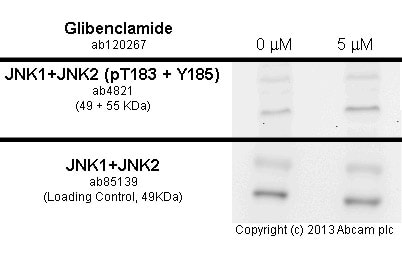Glibenclamide (Glyburide), K+ channel blocker (ab120267)
Key features and details
- K+ channel blocker
- CAS Number: 10238-21-8
- Purity: > 99%
- Soluble in DMSO to 100 mM
- Form / State: Solid
- Source: Synthetic
Overview
-
Product name
Glibenclamide (Glyburide), K+ channel blocker -
Description
K+ channel blocker -
Alternative names
- Glyburide
-
Biological description
Selective blocker of ATP-sensitive (KIR6.x) inward rectifier K+ channels.
-
Purity
> 99% -
CAS Number
10238-21-8 -
Chemical structure

Properties
-
Chemical name
N-p-[2-(5-Chloro-2-methoxybenzamido)ethyl]benzenesulfonyl-N'-cyclohexylurea -
Molecular weight
494.00 -
Molecular formula
C23H28ClN3O5S -
PubChem identifier
3488 -
Storage instructions
Store at Room Temperature. The product can be stored for up to 12 months. -
Solubility overview
Soluble in DMSO to 100 mM -
Handling
Wherever possible, you should prepare and use solutions on the same day. However, if you need to make up stock solutions in advance, we recommend that you store the solution as aliquots in tightly sealed vials at -20°C. Generally, these will be useable for up to one month. Before use, and prior to opening the vial we recommend that you allow your product to equilibrate to room temperature for at least 1 hour.
Need more advice on solubility, usage and handling? Please visit our frequently asked questions (FAQ) page for more details.
-
SMILES
O=C(NC1CCCCC1)NS(=O)(=O)c3ccc(CCNC(=O)c2cc(Cl)ccc2OC)cc3 -
Source
Synthetic
-
Research areas
- Epigenetics and Nuclear Signaling
- Nuclear Signaling Pathways
- Nuclear Receptors
- Orphan Nuclear Receptors
- Metabolism
- Pathways and Processes
- Metabolic signaling pathways
- Lipid and lipoprotein metabolism
- Lipid metabolism
- Metabolism
- Pathways and Processes
- Metabolic signaling pathways
- Lipid and lipoprotein metabolism
- Lipases
- Metabolism
- Pathways and Processes
- Metabolic signaling pathways
- Energy transfer pathways
- Energy Metabolism
Images
-
MEF1 cells were incubated at 37°C for 24h with vehicle control (0 µM) and 5 µM of glibenclamide (ab120267) in DMSO. Increased expression of JNK1+JNK2 (phospho T183 + Y185) (ab4821) correlates with an increase in glibenclamide concentration, as described in literature.
Whole cell lysates were prepared with RIPA buffer (containing protease inhibitors and sodium orthovanadate), 10 µg of each were loaded on the gel and the WB was run under reducing conditions. After transfer the membrane was blocked for an hour using 3% milk before being incubated with ab4821at 1/1000 dilution and ab85139 at 1 µg/ml overnight at 4°C. Antibody binding was detected using an anti-rabbit antibody conjugated to HRP (ab97051) at 1/10000 dilution and visualised using ECL development solution.

